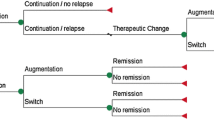Summary
Depression is a widespread and debilitating illness that affects an individual’s ability to carry out their usual activities. It is therefore likely to represent a considerable economic and social burden to society. The prevalence of depression in the elderly has been estimated at around 10%, although it has been suggested that the level of undetected and untreated depression may be especially high in this group. The direct and indirect costs associated with depression in the elderly are therefore likely to be considerable.
The application of economic analysis to drug therapy in the treatment of depression has so far been limited. There are no economic studies of the cost effectiveness of antidepressant drug therapy that concentrate exclusively on the treatment of the elderly. Available evidence across all age groups suggests that selective serotonin reuptake inhibitors may be more cost effective than tricyclic antidepressants. This is primarily attributable to the lower incidence of adverse effects with the former. Whilst these results may be replicated in the elderly, there are specific characteristics of the elderly population which suggest that it may not be possible to generalise results. These include adverse effects, the costs of detection, the costs of noncompliance, and indirect costs and benefits. Therefore, further research and careful economic evaluation of the treatment of depression in the elderly is necessary to take account of these characteristics.
Similar content being viewed by others
References
West R. Depression. London: Office of Health Economics, 1992
Angst J. Epidemiology of depression. Psychopharmacology 1992; 106 Suppl.: S71–4
Copeland JR, Davidson IA, Dewey ME, et al. Alzheimer’s disease other dementias, depression and pseudo-dementia: prevalence, incidence and three year outcome in Liverpool. Br J Psychiatry 1992; 161: 230–9
Iliffe S, Haines A, Gallivan S, et al. Assessment of elderly people in general practice. Br J Gen Pract 1991; 41: 9–12
MacDonald AJ. Do general practitioners miss depression in elderly patients? BMJ 1986; 292: 1365–7
Katona CL. Approaches to the management of depression in old age. Gerontology 1994; 40Suppl. 1: 5–9
Stoudemire A, Frank R, Hedemark N, et al. The economic burden of depression. Gen Hosp Psychiatry 1986; 8: 387–94
Greenberg PE, Stiglin LE, Finkelstein SN. The economic burden of depression in 1990. J Clin Psychiatry 1993; 54: 405–18
Kind P, Sorensen J. The costs of depression. Int Clin Psychopharmacol 1993; 7: 191–5
Rice DP, Miller LS. The economic burden of affective disorders. Br J Psychiatry 1995; 166Suppl. 27: 34–42
Katona CL. Rationalising antidepressants for elderly people. Int Clin Psychopharmacol 1995; 10Suppl. 1: 37–40
Georgotas A, McCue RE, Cooper TB, et al. How effective and safe is continuation therapy in elderly depressed patients? Arch Gen Psychiatry 1988; 45: 929–32
Old Age Depression Interest Group. How long should the elderly take antidepressants? A double blind placebo-controlled study of continuation/prophylaxis therapy with dothiepin. Br J Psychiatry 1993; 162: 175–82
Feighner JP, Cohn JB. Double blind comparative trials of fluoxetine and doxepin in geriatric patients with major depressive disorder. J Clin Psychiatry 1985; 46: 20–5
Guze BH, Freedman DX. Psychiatry. JAMA 1991; 265: 3164–5
Reynolds CF. Treatment of depression in late life. Am J Med 1994; 97Suppl. 6A: 39S–46S
Drummond MF, Stoddart GL, Torrance GW. Methods for the economic evaluation of health care programmes. New York: Oxford University Press, 1988
Boyer WF, Feighner JP. The financial implications of starting treatment with a selective serotonin reuptake inhibitor or tricyclic antidepressant in drug-naive depressed patients. In: Jönsson B, Rosenbaum J, editors. Health economics of depression. Chichester: Wiley, 1993: 65–76
Song F, Freemantle N, Sheldon TA, et al. Selective serotonin reuptake inhibitors: meta analysis of efficacy and acceptability. BMJ 1993; 306: 683–7
McGuire A, Hughes D. The economic evaluation of depression. Postgrad Med J 1994; 70Suppl. 2: S14–22
Jönsson B, Bebbington PE. Economic studies of the treatment of depressive illness. In: Jönsson B, Rosenbaum J, editors. Health economics of depression. Chichester: Wiley, 1993: 35–48
Kamlet MS, Wade M, Kupfer DJ, et al. Cost-utility analysis of maintenance treatment for recurrent depression: a theoretical framework and numerical illustration. In: Frank R, Manning WG, editors. Economics and mental health. Baltimore (MD): Johns Hopkins University Press, 1992: 265–91
Hatziandreu EJ, Brown RE, Revicki DA, et al. Cost utility of maintenance treatment of recurrent depression with sertraline versus episodic treatment with dothiepin. PharmacoEconomics 1994; 5: 249–64
Lane R, MacDonald G. Reducing the economic burden of depression. Int Clin Psychopharmacol 1995; 9: 229–43
Murphy E, Smith R, Lindesay J, et al. Increased mortality in late-life depression. Br J Psychiatry 1988; 152: 347–53
Rosenbaum JF. Clinical choices, cost-effectiveness and antidepressant treatments. In: Jönsson B, Rosenbaum J, editors. Health economics of depression. Chichester: Wiley, 1993: 141–8
Author information
Authors and Affiliations
Rights and permissions
About this article
Cite this article
Hughes, D., Morris, S. & McGuire, A. The Cost of Depression in the Elderly. Drugs & Aging 10, 59–68 (1997). https://doi.org/10.2165/00002512-199710010-00006
Published:
Issue Date:
DOI: https://doi.org/10.2165/00002512-199710010-00006




